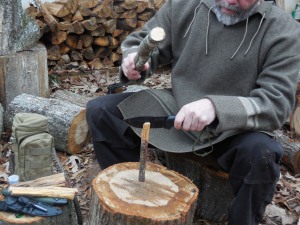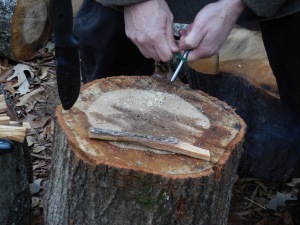Posted by Pam Hillman, with guest Matt Walker, the "Survival Sherpa"
A couple of weeks ago, I attended a local festival and had the opportunity to look over a friend's exquisite carvings made from pine lighter'd. Later, I mentioned it to some friends and they didn't know what lighter'd was.
Okay, as a country girl from the South, that floored me. I just figured that everybody knew what lighter'd was. So, anyway, I decided to blog about pine lighter'd..."fat lighter," "lighter wood," "rich lighter," "pine knot," "lighter knot," or "heart pine". Take your pick!
But why reinvent the wheel?
Matt Walker, the Survival Sherpa had already written an awesome post telling his readers all about fat lighter'd, with pictures.
So, without further ado, here's Matt to tell you all about lighter'd....
Uncle Otha would tell us boys to gather some ‘fat lighter’d’ while out hunting squirrels. He was a retired Army cook and our personal camp chef. Squirrel stew at its finest!
What is fat lighter’d?
You may know it by another name – fatwood, lighter wood, fat lighter, pine knot, or some other alias. Fat lighter’d, as Uncle Otha called it, is a 100% nature-made fire starter. The resin in conifers concentrates in the base of the tree. If a pine is cut down or dies by disease or storm, the pine resin will harden and preserve the wood.
While hunting yesterday, I ran across what you’d look for when searching for fat lighter’d.
The base of the tree’s trunk had been damaged. Pitch (resin) had moved to the area to seal the wound. Though it had not been dead for too many years, fatwood had already formed around the existing injury.
You can also find fat lighter’d stumps and heart pine core preserved on the ground. Old homestead fence posts turn into fatwood as well.
How to use fat lighter’d
Cut the fatwood into 6 to 8 inch long sections. I like to split these sections into finger size pieces. If you’re in the field, you’ll need a baton and knife for splitting kindling.
 Fat lighter’d splits easily and can be done without a baton. With short pieces, it’s better to be safe than sorry.
Fat lighter’d splits easily and can be done without a baton. With short pieces, it’s better to be safe than sorry.
With your cutting tool, make a feather stick from one piece of fatwood. The curled strips will catch a flame and ignite the remaining stock of lighter’d. Even if wet, it catches fire quickly.
The above photo shows me using a butane lighter. You can also start fatwood with a ferro rod.
Use the back of your knife to shave fine slivers off the stock. Gather them into a pile and ignite with the sparks from a ferro rod.


Before I could get back to my camera tripod to photo the flaming pile of fine fat slivers, the flame was all but extinguished. The resin is very flammable. Place the resin slivers in your kindling bundle before showering sparks!
Fat Lighter’d Facts from the Professor of Useless Knowledge
- No chemicals or petroleums added
- Smoke from fat lighter’d makes a great mosquito repellant
- The longleaf pine, which was clear cut to almost extinction, is the best pitch producing pine tree
- The term ‘fatwood’ came about from the wood in pine stumps being “fat” with resin that was highly flammable
- There are between 105 and 125 species classified as resinous pine trees around the world. ~ Wikipedia
If your area doesn’t produce fatwood, what natural fire starter do you prefer?
Keep Doing the Stuff,
Todd
P.S. – You can also connect with us on Twitter, Pinterest, Google +, and our Facebook page.
Thanks for sharing the stuff!
Originally published on the Survival Sherpa blog on 12/31/13. Reprinted with permission.
Pam again: A huge thanks to Matt for letting me share his post. Maybe in the future we'll get to see more great posts from his blog. In the meantime, you have one more day to throw your name in the hat for The 12 Brides of Christmas and The 12 Days of Chrismas Cookbook.











Hope you all enjoyed this post! If you're ever in the woods and need to start a fire...or if you need to use lighter'd or kindling in your writing, you'll be all set. Happy survival skills! :)
ReplyDeletethanks
ReplyDelete